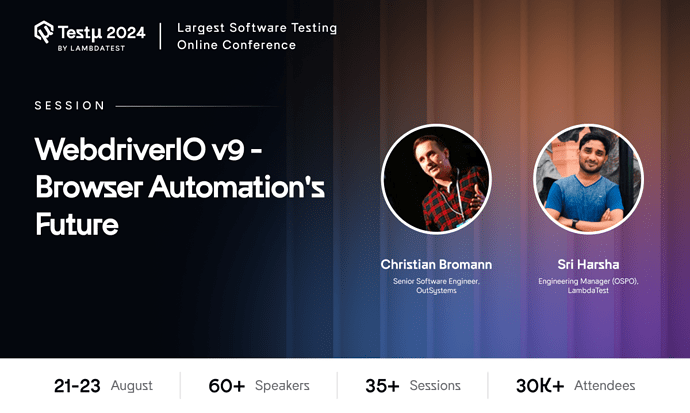 Discover the latest advancements in WebdriverIO, explore best practices, and get a glimpse of what’s next in browser automation. Whether you’re new to WebdriverIO or looking to sharpen your skills, this session has something for everyone!
Discover the latest advancements in WebdriverIO, explore best practices, and get a glimpse of what’s next in browser automation. Whether you’re new to WebdriverIO or looking to sharpen your skills, this session has something for everyone!
Don’t miss out on this opportunity to learn from the best in the industry. Register now, and come prepared with your questions! 

 Ask your questions below in the thread and get them answered live!
Ask your questions below in the thread and get them answered live! 

Hi there,
If you couldn’t catch the session live, don’t worry! You can watch the recording here:
Here are some of the Q&As from this session:
Can you explain how WebdriverIO v9 integrates with modern testing frameworks and CI/CD pipelines?
Sri Harsha: WebdriverIO v9 integrates with modern testing frameworks like Mocha, Jasmine, and Cucumber for behavior-driven development. It supports parallel execution and test retries, enhancing test efficiency. For CI/CD pipelines, WebdriverIO integrates seamlessly with tools like Jenkins, GitLab CI, and GitHub Actions, allowing automated test execution, reporting, and feedback as part of the continuous integration and deployment process.
Now, let’s look into unanswered questions.
What are the key new features in WebdriverIO v9? How can they improve our browser automation?
Can you share insights into the future direction of WebdriverIO and how it plans to stay ahead in the rapidly evolving testing industry?
What will the play write roadmap for future be with such AI hype ?
How can we incorporate playewrite best practices to stay relevant in this AI market ?
What are the challenges in upgrading to WebdriverIO v9 from earlier versions, particularly in terms of backward compatibility and existing test suites?
How does WebdriverIO v9’s approach to browser automation compare with other popular tools like Selenium or Cypress?
How does WebdriverIO handle waiting for elements to appear or become interactive?
How can I use WebdriverIO to test mobile web applications or responsive designs?
What does the future of browser automation look like, and how does WebdriverIO v9 position itself in that vision?
How does the TypeScript runtime environment improve code maintainability and type safety in WebDriverIO projects?
What are the key areas of focus for future development in WebDriverIO, and what new features or improvements can we expect?
Which key feature will be game changer for WebdriverIO?
Can you share the roadmap for WebDriverIO through the end of the year, so we get a sense what features and updates are coming?
How does WebdriverIO v9 position itself for future trends in browser automation, such as the increasing importance of headless testing or the rise of WebAssembly?
How does improved argument serialization simplify passing complex data structures to browser scripts?
is the WebDriverIO 9 version stable and ready to use?
What assistance and support does WebDriverIO most need at present?
![]() Discover the latest advancements in WebdriverIO, explore best practices, and get a glimpse of what’s next in browser automation. Whether you’re new to WebdriverIO or looking to sharpen your skills, this session has something for everyone!
Discover the latest advancements in WebdriverIO, explore best practices, and get a glimpse of what’s next in browser automation. Whether you’re new to WebdriverIO or looking to sharpen your skills, this session has something for everyone!![]()
![]()
![]() Ask your questions below in the thread and get them answered live!
Ask your questions below in the thread and get them answered live! ![]()
![]()

